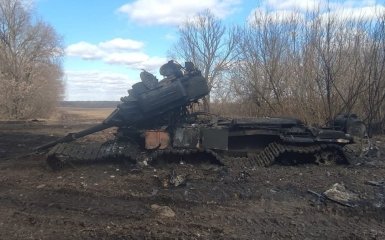According to Julian Ropke, a military analyst for the German newspaper Bild, the Russian occupation army's offensive involving the so-called ‘turtle tanks’ has completely failed.
What is known about the failure of the Russian army’s offensive in the direction of Krasnohorivka
The analyst emphasised that just a few days ago, a column of tanks belonging to the Russian occupiers left Maryinka and headed towards Krasnohorivka.
The convoy was led by an ordinary tank, followed by four metal-clad "turtle tanks" that transported infantry.
The analyst emphasised that the armored vehicles managed to travel about 7 km along the railway tracks.
The Armed Forces fired at the convoy with artillery and mortars, including cluster munitions. Only one tank turned back after landing, Ropke emphasises.
According to the analyst, units of the Russian occupation army in Krasnohorivka found themselves in a difficult situation, as the Armed Forces of Ukraine almost deprived them of supplies and established control over one of the districts.
How should Western partners adjust the approved aid to Ukraine
According to The Times journalists, the US approval of additional aid to Ukraine gives hope for the expansion of the participation of Western partners in the criminal war unleashed by Russia.
However, in order to demonstrate the interest of Western partners in the existence of a stable, democratic and prosperous Ukraine, they should supplement the aid packages with at least four more items.
First, the West must correctly present its military spending — not as an annoying encroachment on our standard of living, but as a worthy collective sacrifice designed to make our societies stronger and more resilient, the publication says.
In particular, the journalists of the publication suggested organising crowdfunding on the territory of European countries for the purchase of unmanned aerial vehicles and their transfer to the Ukrainian military.
In addition, it is proposed to send detained boats with migrants to Ukraine, as well as ambulances.
The publication notes that although all this is unlikely to bring victory in the war, it is not trivial, and it stimulates popular participation in the Ukrainian cause.
Second, governments can also take greater risks to make military aid more effective.
The authors of the material emphasise that during the training of Ukrainian soldiers according to NATO standards, they are often "taught a different type of war, which does not take into account the acute shortage of people and ammunition in Ukraine, its culture of improvisation."
The publication also emphasises that it is better to conduct training in the west of Ukraine, and not abroad, and that private contractors, ex-military personnel should be hired for this work.
The third point, the publication notes, is that the Ukrainians and their sponsors need to increase the pace of operations, as the Russians, making up for lost time, find ways to neutralise the benefits of some of the high-tech weapons that were transferred to the Ukrainians.
And the fourth point is the opportunity to use weak points in the Russian chain of command. As the publication notes, Russia's weak point is the extreme mistrust between officers on the ground and the often corrupt general staff.



